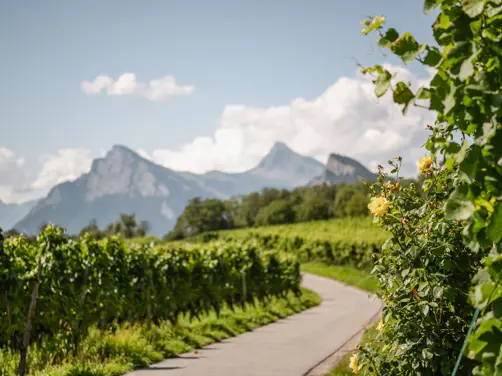Alpine vineyards
The Bündner Herrschaft is one of Switzerland’s best-known wine-growing regions. Among the grape varieties, Pinot noir leads the pack. Traditional and innovative winegrowers also cultivate a number of exciting specialities in white and red—an introduction to a small region of great wines.

The growing region of the Bündner Herrschaft and the Bündner Rheintal stretches across 420 hectares from Bonaduz to Fläsch along the Rhine. Small vineyards are also located in the remote Misox, which is still part of the canton of Graubünden despite accents of the Ticino region.
Among the grape varieties to set the tone is Pinot noir, also known as Blauburgunder. More than 40 other varieties are also cultivated from fresh Riesling-Silvaner and the local speciality Completer, to known grapes like Chardonnay, Sauvignon Blanc, and Merlot. The grapes grow mainly in limestone-rich soil in this mild climate in an area known to be amongst the warmest in Switzerland.
Graubünden produces very different but primarily varietal wines with individual characters. Pinot noir comes forward with a fruity emphasis without using wood. Complex, powerful crus are matured in barrels. Due to the diversity of locally-cultivated varieties, a wide range of styles is available in white wines.
Most of the approximately 340 winegrowers supply their grapes to larger wineries. The winegrowers who cellar their own grapes make their living from the wine, with farmers owning an average of only 1.4 hectares of land. The wine harvests fluctuate depending on the year. 2020, for example, saw the production of about 15,000 hectolitres, while 2021 saw around 20,000 hectolitres.
The majority of the wines produced are sold directly from the vineyards, mainly to customers in German-speaking Switzerland. The same applies to wines from the Bündner Herrschaft, where exports are virtually non-existent. One major exception are the Graubünden-based winegrowers, Daniel and Martha Gantenbein from Fläsch, who sell a good 40 per cent of their production abroad.
he wine lists of renowned establishments, such as Grand Resort Bad Ragaz and Schloss Schauenstein, boast a wide range of gems from this region. Wines from Graubünden are prominently represented. The Alter Torkel restaurant in Jenins exclusively stocks wines from Graubünden.
Prices for wines of the Bündner Herrschaft region have risen steadily in recent years due to higher costs and increasing demand. Twenty francs will get you a good quality bottle, while an excellent barrel wine easily sells for 50 to 60 francs. Selected wines can fetch even more.
The Bündner Herrschaft is unique and often called the ‘Burgundy of Switzerland’. Pinot noir also plays an essential role in other German-speaking regions of Switzerland, such as Zurich, Thurgau, Aargau, and Schaffhausen, which markets itself as Blauburgunderland.
There are two options for tasting or purchasing a Graubünden wine: visit a winery and buy your favourites on the spot, or order a glass or bottle of fine Pinot noir in a restaurant you can trust.
If I had to characterise the Bündner Herrschaft region in three phrases, they would be great wine-making personalities, pioneers of excellent Pinot noir wines, and beautiful landscapes paired with top gastronomy.
Words0 Peter Keller






